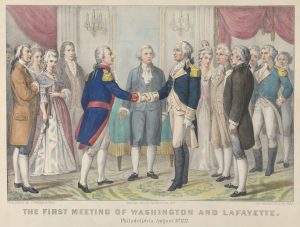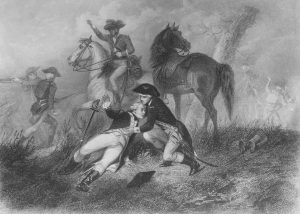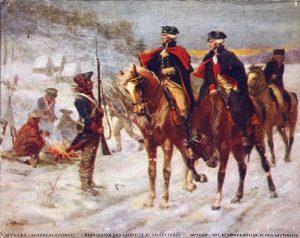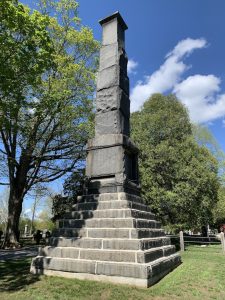Brandywine Stories: The Teenage Revolutionary
Marquis de Lafayette and his connection to Chester County

It was Great Britain’s Duke of Gloucester who, in 1775, first inspired the 18-year-old Marquis de Lafayette with stories about American freedom fighters at Lexington and Concord, three thousand miles away. Those first battles would soon evolve into the American War for Independence and inspire others across the Atlantic to topple their own governments.
Lafayette had good reason to join the American Revolution. For him, it was personal. When he was just two years old, his father was killed by the British during the Seven Years’ War against France. When he grew into a young man, Lafayette felt fully justified to avenge his father’s death. He reasoned that if fighting the British Army also meant independence for the Americans, all the better.
Having inherited his family’s fortune, Lafayette purchased a sailing ship to take him on the three-month journey across the Atlantic. First landing in South Carolina, he soon made his way to Philadelphia.

When the 19-year-old arrived, his self-confidence and proud demeanor convinced the Second Continental Congress — with the support of George Washington and Benjamin Franklin — to pass a resolution on July 31, 1777, that the services of Marquis de Lafayette “be accepted, and that, in consideration of his zeal, illustrious family and connections, he have the rank and commission of major-general of the United States.” Despite the impressive language, he was given no command. Still, not bad for a young foreigner with no combat experience who could barely speak English. But the action allowed Lafayette to defy both the British and French monarchies who were working hard to keep a fragile peace with each other.
This alliance with Lafayette became a political opportunity for Washington, who hoped to leverage the situation into political and military support from France. This would give the British another enemy — always a good tactic for depleting an adversary’s resources. Eventually, France did become an ally, providing arms, ammunition, uniforms and even troops to the beleaguered Continental Army.
Battle of Brandywine

In southern Chester County, near the 1753 Birmingham Meeting House, a first line of defense of the American Army was established on the morning of September 11, 1777. The Battle of Brandywine — the largest single-day battle of the Revolution — would soon begin. The Meeting House itself was used as a hospital for wounded soldiers on both sides.
Lafayette joined the army troops and became a champion when he determined that despite the bravery of the outnumbered revolutionaries, the battle would be lost. He quickly mustered the American troops into a retreat but was wounded by a rifle bullet to his calf. Instead of seeking medical attention at the field hospital, the young soldier stayed with his comrades, successfully guiding them to safety.

Though this battle was lost, British forces had to face the fact that they would not be able to quell the revolution quickly. They shifted their forces to overrun Philadelphia, forcing the young government to move its capital to York, Pennsylvania. Meanwhile, George Washington’s army made its way to Valley Forge, where it rested, recovered and trained during the harsh winter.
Once there, the friendship between Washington and Lafayette grew. The young Frenchman became the son George Washington never had. And the feeling was mutual. In 1779, Lafayette named his only son George Washington Lafayette.
Lafayette eventually commanded Continental Army troops, including at the decisive battle at Yorktown in 1781, the last major land battle.
The Return of Lafayette
In 1824, at the invitation of President Monroe and Congress, Lafayette returned to the United States and visited 24 states in 14 months. As one of the last living survivors of the Revolution, he was met with adulation at every stop. In West Chester, Lafayette was given a royal welcome with several opportunities to feast with locals and share goodwill.
The high point of that visit is commemorated by what’s considered the first marker to interpret a historical event in West Chester. Located on Lafayette Street near Walnut Street, the stone marker states: “From this spot July 26, 1825 Marquis de Lafayette reviewed the troops escorting him from a visit to the Brandywine Battlefield.” It further indicates that it was “Erected by a member of The Society of Sons of the American Revolution.”
This early monument is part of a movement of patriotic organizations seeking to have Lafayette’s name placed throughout America. Today, it’s estimated that over 200 counties, cities, towns, parks and other places are named after Lafayette. For his part, Lafayette carried his connection to the United States to his grave — he was buried under soil from Bunker Hill.
It’s no wonder the name of this Frenchman — also known as the Hero of Two Worlds for his role in the French Revolution and authorship of the Declaration of the Rights of Man and of the Citizen — is known to American schoolchildren today.
To learn more, attend the second Lafayette Celebration, July 20, 2024, 11 to 3, hosted at Thornbury Farm, part of the 200th anniversary of Lafayette’s visit to the U.S. and part of Chester County’s 250 celebration. See Revolutionary War artifacts, hear honored guests and preview a movie on the Battle of Brandywine, Lafayette and the necessity of preserving historic land. 1256 Thornbury Rd., West Chester. Lafayette200.org.
Historic Sites

Many fields where the Battle of Brandywine was fought can still be seen throughout Chester County. A notable site is the Brandywine Conservancy & Museum of Art’s Birmingham Hill Preserve, site of the first and second defensive lines of the Continental Army during the battle.
The Birmingham Hill Brandywine Battlefield Trail, located on Birmingham Road between Meetinghouse and Thornbury Roads, allows visitors to experience the “hallowed ground where Americans fought and died to establish our liberties and a new nation.”
Nearby is the Birmingham Lafayette Cemetery, a National Historic Landmark. Today, several monuments stand proudly at the entrance recognizing the Battle of Brandywine, Lafayette and other notable local figures.
 Malcolm Johnstone is the Community Engagement Officer for Arts, Culture and Historic Preservation for the Cultural Alliance of Chester County, an initiative of the Chester County Community Foundation. His column raises awareness of Chester County’s rich heritage as we journey to 2026: the year the U.S. celebrates the 250th anniversary of our nation’s independence.
Malcolm Johnstone is the Community Engagement Officer for Arts, Culture and Historic Preservation for the Cultural Alliance of Chester County, an initiative of the Chester County Community Foundation. His column raises awareness of Chester County’s rich heritage as we journey to 2026: the year the U.S. celebrates the 250th anniversary of our nation’s independence.
